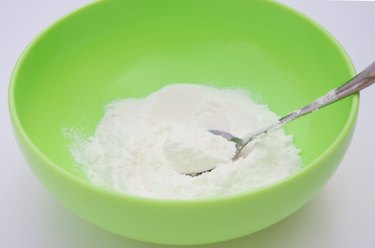
Milk powder and milk mawa powder can be the very same thing, provided that they both have full-fat contents. In some cases, however, you may have to do some searching to find mawa powder, since many stores sell only powdered nonfat milk, which won't produce the same richness and texture in mawa desserts.
Basics
Video of the Day
Mawa is another term for khoa or khoya, which denotes a milk byproduct that is frequently used in Indian desserts. Mawa is thicker than regular milk and has a consistency similar to that of ricotta cheese or paneer, another soft Indian cheese. To make solid mawa, it's necessary to mix full-fat milk powder or whole milk powder with heavy cream, evaporated milk, or a small amount of liquid whole milk and knead the mixture until it becomes doughy.
Video of the Day
Nutrition
Traditional nonfat milk powder and milk mawa powder have significant nutritional differences. A 30-gram scoop of nonfat milk powder, which is just over 1/4 cup and can produce approximately 1 cup of liquid milk, has no fat, 6 milligrams cholesterol, about 15.5 grams sugar, about 11 grams protein and 108 calories. The same amount of mawa milk powder or whole milk powder has 9 grams fat, 30 milligrams cholesterol, 12 grams sugar, 8 grams protein and 150 calories. Health-wise, nonfat milk powder is a better choice than mawa powder because of its higher protein content and lower fat and calorie counts. The USDA encourages consumers to choose low-fat or nonfat milk and dairy products over full-fat varieties, which contain more "empty calories."
Texture
Milk mawa powder is also likely to have a different texture than regular milk powder. This is due to the fact that mawa powder may be curdled before it's evaporated, giving it a final texture that's rough or granulated. While nonfat milk powder and low-fat varieties can clump up in extended storage, they tend to be smoother and have smaller granules.
Considerations
It's important to realize that mawa comes in several different versions and that not all of them have the same texture, characteristics, taste or nutritional content. Prepared mawa that isn't made with powder may contain some buffalo milk and have a higher fat content and a less "grainy" texture. According to Chef in You, it's also possible to make a smooth and rich version of mawa using only liquid whole milk that is cooked until it's reduced and curdled.